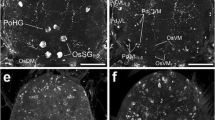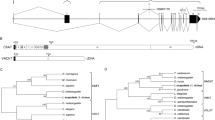Abstract
Dopamine (DA) content of the salivary glands in partially fed female and fed male ticks, Amblyomma hebraeum Koch (Acari: Ixodidae), was measured by high-performance liquid chromatography with electrochemical detection or by a radioenzymatic assay for catecholamines following experimental treatment. Some glands were held in vitro for up to 3 days. Other preparations (‘backless explants’) allowed one side to be surgically denervated, the contralateral side serving as control. Normal ticks were sampled for up to 4 days post-removal from the host (rabbits). In the backless explants, there was little if any difference in DA content between denervated and control sides, even after 4 days in vitro, indicating that unilateral denervation did not eliminate the major salivary gland pool of DA. High doses of reserpine (333 μg per g body weight) and 6-hydroxydopamine (1000 μg per g body weight) did not significantly reduce the DA content of the salivary gland, also suggesting that only a minor component of the DA pool is within axons innervating the salivary gland. A dispersed population of cells rich in tyrosine hydroxylase immunoreactivity (an enzyme marker for catecholamine-synthesizing cells) was found in close association with the granular acini. This further suggests that the major DA pool in the salivary gland may be in cells other than the dopaminergic nerves arising from the central nervous system. © Rapid Science Ltd. 1998
Similar content being viewed by others
REFERENCES
Bell, L.J. 1980. Organ culture of Rhipicephalus appendiculatus with maturation of Theileria parva in tick salivary glands in vitro. Acta Trop. 37: 319–325.
Berkowitz, B.A. 1983. Dopamine and dopamine receptors as target sites for cardiovascular drug action. Fed. Proc. 42: 3019–3021.
Binnington, K.C. 1978. Sequential changes in salivary gland structure during attachment and feeding of the cattle tick, Boophilus microplus. Int. J. Parasitol. 8: 97–115.
Binnington, K.C. 1981. Innervation of coxal muscles, heart and other organs in the cattle tick, Boophilus microplus Canestrini (Acarina: Ixodidae). Int. J. Insect Morphol. Embryol. 10: 109–119.
Binnington, K.C. and Stone, B.F. 1977. Distribution of catecholamines in the cattle tick, Boophilus microplus. Comp. Biochem. Physiol. 58C: 21–28.
Binnington, K.C. and Tatchell, R.J. 1973. The nervous system and neurosecretory cells of Boophilus microplus (Acarina, Ixodidiae). Z. Wiss. Zool. Leipzig 185: 193–206.
Burnstock, G. and Costa, M. 1975. Adrenergic neurons. Chapman & Hall, London.
Byck, R. 1975. Drugs and the treatment of psychiatric disorders. In The pharmacological basis of therapeutics, 5th edn, L.S. Goodman and A. Gilman (eds), pp. 152–200. Macmilllan Publishing Co., New York.
Chinery, W.A. 1965. Studies on the various glands of the tick Haemaphysalis spinigera Neumann 1897. Part III. The salivary glands. Acta Trop. 22: 321–349.
Cooper, T. 1966. Surgical sympathectomy and adrenergic function. Pharmacol. Rev. 18: 611–618.
Edvinsson, L., Owman, Ch., Rosengren, E. and West, K.A. 1972. Concentration of noradrenaline in pial vessels, choroid plexus and iris during two weeks after sympathetic ganglionectomy or decentralization. Acta Physiol. Scand. 85: 201–206.
El Shoura, S.M. 1985. Salivary gland ultrastructure of the unfed adult and feeding female of Haemaphysalis (Rhipistoma) leachi (Ixodoidea: Ixodidae). J. Morphol. 186: 31–44.
Falk, B., Hillarp, N.A., Thieme, G. and Torp, A. 1962. Fluorescence of catecholamines and related compounds condensed with formaldehyde. J Histochem. Cytochem. 10: 348–354.
Finch, L., Haeusler, H., Kuhn, H. and Thoenen, H. 1973. Rapid recovery of vascular adrenergic nerves in the rat after chemical sympathectomy with 6–hydroxydopamine. Br. J. Pharmacol. 48: 59–72.
Goldberg, J.I. and Kater, S.B. 1989. Expression and fuction of the neurotransmitter serotonin during development of the Helisoma nervous system. Devol. Biol. 131: 483–495.
Goldberg, L.I., Volkman, P.H. and Kohli, J.D. 1978. A comparison of the vascular dopamine receptor with other dopamine receptors. Ann. Rev. Pharmacol. Toxicol. 18: 57–79.
Hadley, M.E. 1996. Endocrinology, 4th edn. Prentice Hall.
Harris, R.A. and Kaufman, W.R. 1985. Ecdysteroids: possible candidates for the hormone which triggers salivary gland degeneration in the ixodid tick Amblyomma hebraeum. Experientia 41: 740–742.
Hills, J.M. and Jessen, K.R. 1992. Transmission: γ-aminobutyric acid (GABA), 5–hydroxytryptamine (5–HT) and dopamine. In Autonomic neuroeffector mechanisms, G. Burnstock and C.H.V. Hoyle (eds), pp. 465–507. Harwood Academic Publishers, Chur, Switzerland.
Jonsson, G. and Sachs, C. 1970. Synthesis of noradrenaline from 3,4–dihydroxyphenylalanine (DOPA) and dopamine in adrenergic nerves of mouse atrium — effect of reserpine, monoamine oxidase and tyrosine hydroxylase inhibition. Acta Physiol. Scand. 80: 307–322.
Kaufman, W.R. 1978. Actions of some transmitters and their antagonists on salivary secretion in a tick. Am. J. Physiol. 235: R76–R81.
Kaufman, W.R. 1983. The function of tick salivary glands. In Current topics in vector research, K.F. Harris (ed.), pp. 215–247. Praeger Scientific, New York.
Kaufman, W.R. 1989. Tick-host interaction — a synthesis of current concepts. Parasitol. Today 5: 47–56.
Kaufman, W.R. 1990. Organ culture of ixodid-tick salivary glands. Exp. Appl. Acarol. 9: 79–86.
Kaufman, W.R. and Harris, R.A. 1983. Neural pathways mediating salivary fluid secretion in the ixodid tick Amblyomma hebraeum. Can. J. Zool. 61: 1976–1980.
Kaufman, W.R. and Sloley, B.D. 1996. Catabolism of dopamine and 5–hydroxytryptamine by monoamine oxidase in the ixodid tick, Amblyomma hebraeum. Insect Biochem. Mol. Biol. 26: 101–109.
Kaufman, W.R. and Wong, D.L.-P. 1983. Evidence for multiple receptors mediating fluid secretion in salivary glands of ticks. Eur. J. Pharmacol. 87: 43–52.
Kostrzewa, R.M. and Garey, R.E. 1976. Effects of 6–hydroxydopa on noradrenergic neurons in developing rat brain. J. Pharmacol. Exp. Ther. 197: 105–118.
Malmfors, T. and Sachs, C. 1965. Direct studies on the disappearance of the transmitter and change in the uptake-storage mechanisms of degenerating adrenergic nerves. Acta Physiol. Scand. 64: 211–223.
Megaw, M.W.J. and Beadle, D.J. 1979. Structure and function of the salivary glands of the tick, Boophilus microplus Canestrini (Acarina: Ixodidae). Int. J. Insect Morphol. Embryol. 8: 67–83.
Megaw, M.W.J. and Robertson, H.A. 1974. Dopamine and noradrenaline in the salivary glands and brain of the tick, Boophilus microplus: effect of reserpine. Experientia 30: 1261–1262.
Muscholl, E. and Vogt, M. 1958. The action of reserpine on the peripheral sympathetic system. J. Physiol. Lond. 141: 132–155.
Sauer, J.R., McSwain, J.L., Bowman, A.S. and Essenberg, R.C. 1995. Tick salivary gland physiology. Annu. Rev. Entomol. 40: 245–267.
Sloley, B.D. and Goldberg, J.I. 1991. Determination of γ-glutamyl conjugates of monoamines by means of high-performance liquid chromatography with electrochemical detection and application to gastropod tissues. J. Chromatogr. 567: 49–56.
Sloley, B.D. and Owen, M.D. 1982. The effect of reserpine on amine concentrations in the nervous system of the cockroach (Periplaneta americana). Insect Biochem. 12: 469–476.
Sloley B.D., Juorio, A.V. and Durden, D.A. 1990. High-performance liquid chromatographic analysis of monoamines and some of their γ-glutamyl conjugates produced by the brain and other tissues of Helix aspersa (Gastropoda). Cell. and Mol. Neurobiol. 10: 175–192.
Sonenshine, D.E. 1993. Biology of ticks, vol. 2. Oxford University Press, New York, Oxford.
Stuttgen, G. and Dreesen, R. 1979. Dopamine effects on the microcirculation and veins of the skin after local application and their changes by antagonistic drugs. Arch. Dermatol. Res. 266: 59–73.
van Woerkens, L.J., Man in 't Veld, A.J., van der Giessen, W.J., van Meegen, J., Boosma, F. and Verdouw, P.D. 1992. Effect of epinine on systemic hemodynamics and regional blood flow in conscious pigs. J. Cardiovasc. Pharmacol. 19: 580–586.
Willems, J.L., Buylaert, W.A., Lefebvre, R.A. and Bogaert, M.G. 1985. Neuronal dopamine receptors on autonomic ganglia and sympathetic nerves and dopamine receptors in the gastrointestinal system. Pharmacolog. Rev. 37: 165–216.
Author information
Authors and Affiliations
Rights and permissions
About this article
Cite this article
Kaufman, W.R., Sloley, B.D., Tatchell, R.J. et al. Quantification and cellular localization of dopamine in the salivary gland of the ixodid tick Amblyomma hebraeum. Exp Appl Acarol 23, 251–265 (1999). https://doi.org/10.1023/A:1006071031547
Issue Date:
DOI: https://doi.org/10.1023/A:1006071031547




